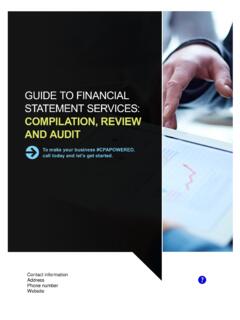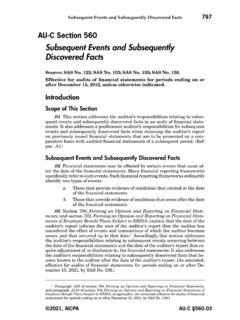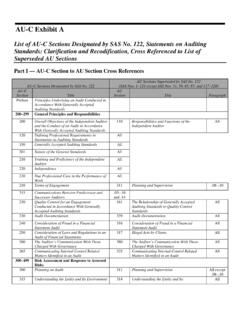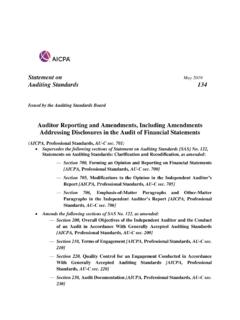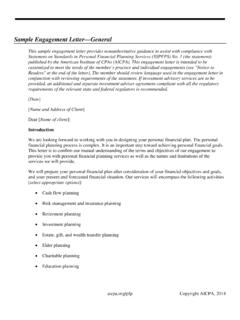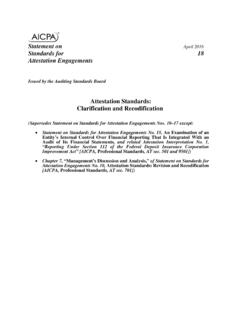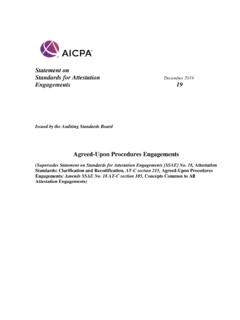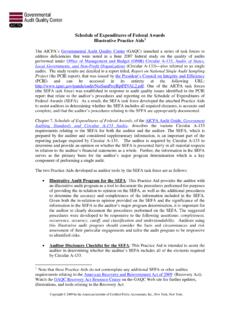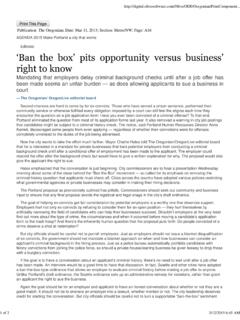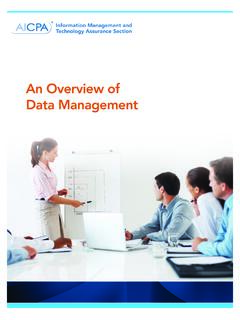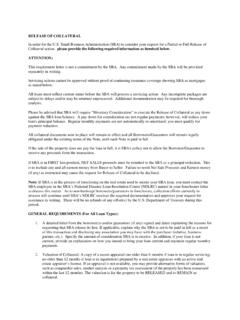Transcription of Q&A Section 3200 - AICPA
1 2020 Association of International Certified Professional Accountants. All rights reserved. For information about the procedure for requesting permission to make copies of any part of this work, please email with your request. Otherwise, requests should be written and mailed to the Permissions Department, 220 Leigh Farm Road, Durham, NC 27707-8110. Q&A Section 3200 Long-Term Debt .18 Borrower Accounting for a Forgivable Loan Received Under the Small Business Administration Paycheck Protection Program Inquiry How should a nongovernmental entity1 account for a forgivable loan received under the Small Business Administration Paycheck Protection Program (PPP)2? Reply Given the unique nature of the PPP, questions have arisen relating to how a borrower under the program should account for the arrangement. Although the legal form of the PPP loan is debt, some believe that the loan is, in substance, a government grant. Staff of the Office of the Chief Accountant of the SEC have indicated they would not object to an SEC registrant accounting for a PPP loan under FASB Accounting Standards Codification (ASC) 470, Debt, or as a government grant by analogy to International Accounting Standard (IAS) 20, Accounting for Government Grants and Disclosure of Government Assistance, provided certain conditions are met.
2 Regardless of whether a nongovernmental entity expects to repay the PPP loan or believes it represents, in substance, a grant that is expected to be forgiven, it may account for the loan as a financial liability in accordance with FASB ASC 470 and accrue interest in accordance with the interest method under FASB ASC 835-30. An entity would not impute additional interest at a market rate (even though the stated interest rate may be below market) because transactions where interest rates are prescribed by governmental agencies (for example, government guaranteed obligations) are excluded from the scope of the FASB ASC 835-30 guidance on imputing interest. For purposes of derecognition of the liability, FASB ASC 470-50-15-4 refers to guidance in FASB ASC 405-20. Based on the guidance in FASB ASC 405-20-40-1, the proceeds from the loan would remain recorded as a liability until either (1) the loan is, in part or wholly, forgiven and the debtor has been legally released or (2) the debtor pays off the loan to the creditor.
3 Once the loan is, in part or wholly, forgiven and legal release is received, a nongovernmental entity would reduce the liability by the amount forgiven and record a gain on extinguishment. If a nongovernmental entity that is not a not-for-profit entity (NFP) (that is, it is a business entity) expects to meet the PPP s eligibility criteria and concludes that the PPP loan represents, 1 References to nongovernmental entities include business entities and not-for-profit entities. 2 Please refer to the Small Business Administration website for information regarding the Paycheck Protection Program. 2020, Association. Unauthorized copying prohibited. in substance, a grant that is expected to be forgiven, it may analogize to IAS 20 to account for the PPP loan. IAS 20 outlines a model for the accounting for different forms of government assistance, including forgivable loans. Under this model, government assistance is not recognized until there is reasonable assurance (similar to the probable threshold in generally accepted accounting principles3) that (1) any conditions attached to the assistance will be met and (2) the assistance will be received.
4 Once there is reasonable assurance that the conditions will be met, the earnings impact of government grants is recorded on a systematic basis over the periods in which the entity recognizes as expenses the related costs for which the grants are intended to compensate. 4 Specifically, a business entity would record the cash inflow from the PPP loan as a deferred income liability. Subsequent to initial recognition, a business entity would reduce the liability, with the offset through earnings (presented as either [1] a credit in the income statement, either separately or under a general heading such as other income, or [2] a reduction of the related expenses), as it recognizes the related cost to which the loan relates, for example, compensation expense. If a nongovernmental entity that is not an NFP (that is, it is a business entity) expects to meet the PPP s eligibility criteria and concludes that the PPP loan represents, in substance, a grant that is expected to be forgiven, the AICPA staff observes it can also analogize5 to the following guidance: (1) FASB ASC 958-605 or (2) FASB ASC 450-30.
5 If an NFP chooses not to follow FASB ASC 470 and it expects to meet the PPP s eligibility criteria and concludes that the PPP loan represents, in substance, a grant that is expected to be forgiven, it should account for such PPP loans in accordance with FASB ASC 958-605 as a conditional contribution. The following table summarizes the key concepts of these models. Accounting Topic Overview FASB ASC 958-605 FASB ASC 958-605 addresses the accounting for contributions by NFPs. Although the scope of FASB ASC 958-605 excludes contributions made by governmental entities to business (for-profit) entities, the FASB staff has acknowledged that entities scoped out of that guidance are not precluded from applying it by analogy when Under this model, the timing of recognition for a contribution received depends on whether the contribution is conditional or not. If conditional, the contribution is not recognized until the conditions are substantially met or explicitly waived. Specifically, a nongovernmental entity would 3 The FASB ASC Master Glossary defines probable as [t]he future event or events are likely to occur.
6 4 Paragraph 12 of IAS 20. 5 FASB ASC 105-10-05-2 explains that, in the absence of explicit guidance, entities should first analogize to other areas of authoritative generally accepted accounting principles before considering other nonauthoritative sources. 6 The issue of business entities analogizing to the guidance in FASB ASC 958-605 was discussed by FASB staff at the Private Company Council meeting on April 17, 2020, as well as by the FASB Not-for-Profit Advisory Committee during its meetings on September 13 14, 2018, and April 7, 2020. 2020, Association. Unauthorized copying prohibited. initially record the cash inflow from the PPP loan as a refundable advance. The nongovernmental entity would then reduce the refundable advance and recognize the contribution once the conditions of release have been substantially met or explicitly waived. FASB ASC 450-30 FASB ASC 450-30 outlines a model for gain contingency recognition. Under this model, the earnings impact of a gain contingency is recognized when all the contingencies related to receipt of the assistance have been met and the gain is realized or realizable.
7 As applied to forgivable loans received under the PPP, a business entity would initially record the cash inflow from the PPP loan as a liability. The proceeds from the loan would remain recorded as a liability until the grant proceeds are realized or realizable, at which time the earnings impact would be recognized. Nongovernmental entities with material PPP loans should adequately disclose their accounting policy for such loans and the related impact to the financial statements. [Issue Date: June 2020.]
